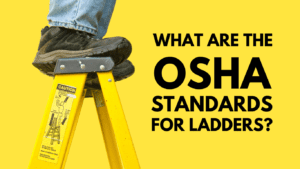What are the OSHA ladder standards?
Comments Off on What are the OSHA ladder standards?Every year in the US, more than 100 people die and thousands are injured from ladder falls. And did you know that ladder-related injuries are among the top three workplace safety violations in the USA?
These statistics pose a question about the safety rules and regulations for ladders. Working at a vulnerable height requires acceptance and commitment to the rules jotted down by the Occupational Safety and Health Administration (OSHA) under OSHA ladder regulations.
This article attempts to cover the core OSHA standards for ladders.
Rules for all osha ladder standards
The following rules are applicable to all types of ladders.
1. Keep ladders free of oil, grease, and other potential slip hazards.
2. Ladders should not be loaded beyond their maximum intended load or their manufacturer-rated capacity.
3. Only use ladders for their intended purpose.
4. Ladders should only be used on stable and level surfaces unless they are secured to prevent accidental movement.
5. Ladders should not be used on slippery surfaces unless they are secured or have slip-resistant feet to prevent accidental movement. Do not substitute slip-resistant feet for caution when placing, lashing, or holding a ladder on slippery surfaces.
6. To prevent accidental movement, secure ladders placed in areas such as passageways, doorways, or driveways, or where they can be displaced by workplace activities or traffic. Or, use a barricade to prevent traffic or activity from approaching the ladder.
7. Maintain a clear perimeter around the top and base of ladders.
8. Ladders should not be moved, shifted, or extended while in use.
9. If the worker or the ladder could come into contact with exposed, energized electrical equipment, use ladders with non-conductive side rails.
10. Face the ladder when climbing or descending.
11. When climbing, use at least one hand to grasp the ladder.
12. Carry no objects or loads that could result in loss of balance and falling.
13. When ladders are the only way to enter or exit a work area with 25 or more employees, or when a ladder serves simultaneous two-way traffic, double-cleated ladders or at least two additional ladders must be provided.
14. When a ladder is ready for use, its rungs, cleats, and steps must be parallel, level, and uniformly spaced.
15. Unless specifically designed for this purpose, ladders may not be tied or fastened together in order to form longer sections.
16. When splicing side rails, the resulting side rail must have the same strength as a side rail made of the same material in a single piece.
Rules for stepladders
1. Do not use the top or top rung as a step.
2. Do not use cross bracing for climbing on the rear section of stepladders unless the ladders are designed and equipped with steps for climbing on both the front and rear sections.
3. Stepladders must be equipped with a metal spreader or locking device to keep the front and back sections in an open position when in use.
Rules for specific types of ladders
1. Do not use single-rail ladders.
2. Use non-self-supporting ladders at an angle such that the horizontal distance from the top support to the foot of the ladder is roughly one-fourth of the ladder’s working length.
3. Utilize wooden ladders constructed on-site with angled side rails so that the horizontal distance is one-eighth of the ladder’s working length.
Rules for portable ladders
1. Any portable ladder needs 11.5 inches (29cm) between the side rails. In addition, portable metal ladders should have dimpled, skid-resistant rungs and steps to reduce slipping.
2. Non-self-supporting and self-supporting portable ladders must support four times the maximum intended load, and type 1A metal or plastic ladders should support 3.3 times. Apply a load to a self-supporting ladder at an angle of 75.5 degrees to determine if it can hold it.
3. Portable ladder side rails must extend at least 3 feet above an upper landing surface when used for access. When this isn’t possible, the ladder should be secured and a grab rail provided to help workers mount and dismount. A ladder extension must not deflect under load to cause slipping.
Rules for fixed ladders
If a fixed ladder’s overall climb length is equal to or greater than 24 feet (7.3m), it should be equipped with safety devices or self-retracting lifelines and rest platforms every 150 feet (45.7m) or a cage or well, and several ladder sections no longer than 50 feet (15.2m). Landing platforms should be spaced 50 feet apart. Fixed ladders must meet these standards:
1. They must support two 250-pound (114kg) loads between any two attachments. Fixed ladders must support added loads from ice, winds, rigging, and ladder safety devices.
2. Individual rung/step ladders should extend at least 42 inches (1.1m) above an access level or landing platform with horizontal grab bars or vertical grab bars with the same lateral spacing as the ladder rails.
3. Every fixed ladder step or rung must support 250 pounds (114kg) in the middle.
4. Minimum 16-inch clear space between rung/step ladders and fixed ladder side rails (41 cm).
5. Ladder rungs must be shaped to prevent slipping.
6. Fixed ladders without cages or wells should have a 15-inch (38cm) clearance on each side of the centerline.
7. Fixed ladders must have cages, wells, ladder safety devices, or self-retracting lifelines if the climb is less than 24 feet (7.3m) but the top of the ladder is higher.
Discover the best uae online games real money options, brought to you by the trusted team of experts at CasinoUAE10 for a secure and thrilling experience.
Osha Rules for temporary stairs
1. Don’t use stairways with metal pan landings and treads if they haven’t been filled with concrete or other materials, unless the pans are temporarily filled with wood or other materials. All worn treads and landings must be replaced.
2. Do not use skeleton metal frame structures and steps (where treads and/or landings will be installed later) without temporary treads and landings.
Osha Rules for stair rails
1. Stair rail systems and handrails must be finished to prevent injuries such as punctures and lacerations and to prevent clothing from becoming entangled.
2. The ends of stair rail systems and handrails must be constructed to prevent dangerous projections, such as rails that extend beyond the system’s end posts.
3. Standard 42-inch (1.1 m) guardrail systems must be installed on unprotected sides and edges of stairway landings.
Osha Rules for handrails
1. Handrails and top rails of stair rail systems must withstand at least 200 pounds (890 n) of downward or outward weight within 2 inches (5 cm) of the top edge.
2. Handrails must be 37 inches (94 cm) or less from the handrail’s top to the tread.
3. Handrails must provide a good grip to prevent falls.
4. Temporary handrails must have a 3-inch (8-cm) clearance from walls, stair rails, and other objects.
5. Stairways with four or more risers or more than 30 inches (76 cm) must have a handrail.
6. Winding or spiral stairways must have a handrail to prevent the use of less-than-6-inch treads (15 cm).
Wrapping up
It can be difficult to keep up with every OSHA ladder rule detail. Often, avoiding unsafe ladder use is as simple as employing common sense. Occasionally, the OSHA ladder safety regulations can be difficult to recall.
Also, to keep up with all the OSHA rules, you need to contact a company that makes scaffolding that meets all the rules. In that case, AAIT is an ideal choice, as scaffold steel ladders and ladder brackets, along with the steel ladder design, satisfy OSHA standards for ladders.
Get an ideal ladder at AAIT today!
KasinoSlovensko10 vám prináša komplexný prehľad o zahraničných online kasínach, ako je kasinoslovensko10.com/zahranicne-online-casino, kde môžete zažiť jedinečnú zábavu a výhody.












 Download
Download